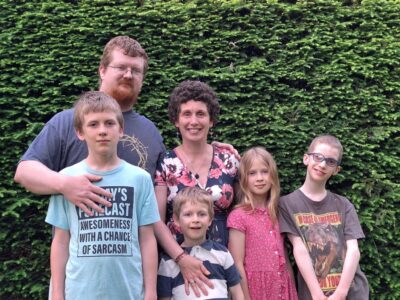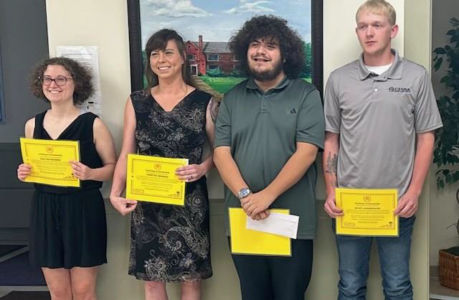New exhibitions to open at Crary Art Gallery
- Photos provided to the Times Observer Nicole Maye Luga’s “Turning Back” along with Maryam Safajoo’s “The Tightness of the Cage” are two of the works that will be featured in upcoming solo exhibitions at the Crary Art Gallery. An opening is set for Sat., April 1 and the exhibitions will be on display through April 30.
- Photos provided to the Times Observer Nicole Maye Luga’s “Turning Back” along with Maryam Safajoo’s “The Tightness of the Cage” are two of the works that will be featured in upcoming solo exhibitions at the Crary Art Gallery. An opening is set for Sat., April 1 and the exhibitions will be on display through April 30.

Photos provided to the Times Observer Nicole Maye Luga’s “Turning Back” along with Maryam Safajoo’s “The Tightness of the Cage” are two of the works that will be featured in upcoming solo exhibitions at the Crary Art Gallery. An opening is set for Sat., April 1 and the exhibitions will be on display through April 30.
Two new, solo exhibitions will grace the Crary Art Gallery starting April 1.
Nicole Maye Luga will show “Everyday Beauty — Familiar Places Celebrated” While Maryam Safajoo’s exhibition is entitled “A Cry From the Heart.”
“In each of these exhibitions, visitors will find works that convey the struggles and fragility of the human experience,” a statement from the Crary said, “and also illuminate the strength of human connection, and ever-present hope for a better world.”
Luga’s style can be described as “contemporary traditionalist.
“Many of the oil paintings in her exhibition focus on bridges or people and buildings in neighborhoods around Cleveland that she directly observed over the last year and a half,” according to the Crary.

Photos provided to the Times Observer Nicole Maye Luga’s “Turning Back” along with Maryam Safajoo’s “The Tightness of the Cage” are two of the works that will be featured in upcoming solo exhibitions at the Crary Art Gallery. An opening is set for Sat., April 1 and the exhibitions will be on display through April 30.
Luga, who lives in Ohio, studied painting at the Pennsylvania Academy of Fine Arts, lived overseas for a time and became a member of the Philadelphia Sketch Club and the National Association of Women Artists when she returned to the states.
“I am inspired by the beauty and complexity of the world around me and how the physical infrastructure we (create) shapes our experience of the world,” Luga said. “Through my work, I aim to capture the poetry of everyday life, the resilience and strength of the human spirit, and the wonders of human engineering
“I am often drawn to bridges as a subject matter because they represent so much more than just a physical structure. They symbolize the idea of connection, of crossing over from one place to another, of bridging the gap between people and cultures.” They represent part of what makes humanity great — our ability to work together, to overcome obstacles, and to create something that is greater than the sum of its parts…. The decay and decline of these structures over time reflect the fragility of our own existence. There is beauty in the marks and remnants of survival, the fleeting moments of the here and now, and the wonders of human engineering that endure for centuries.”
Her work has received numerous awards and is in collections nationwide.
Safajoo is a Persian-American painter whose paintings “narrate her experience of the systematically persecuted Iranian Baha’i community — Iran’s largest religious minority — after the 1979 Iranian revolution,” per the Crary.
“I experienced this oppression myself in Iran,” Safajoo said. “I remember the day in the early morning when government security forces burst into my home, ransacked it and took my father to prison; my younger sister was crying on her way to school. Later, my sister was denied access to university, and because of her quest to understand why, was placed in solitary confinement.
“My paintings narrate these stories which are a result of my conversations and interviews with the people who were near or in these actual events. Many of the incidents I depict only exist in the memory of those who experienced them and have no pictorial existence. In many cases if visual records did exist, they have been confiscated by the Iranian authorities in raids of homes. My depictions are often the first time these events have taken visual form. I record the details of this history. For example, the shoes, clothes, artifacts, and environments seen in my paintings are very close to those that were there in the event.”
The process — each painting is inspired by actual events — includes interviews and research into the stories of the Bahai’s of Iran.
“Throughout my work, I am constantly reflecting on the concept of a humanity free from prejudice; that is how we can eliminate our prejudices against any people — on the basis of color, nationality, gender or identity, economic or educational status,” she added.
Her work has or will be exhibited at Harvard, the International Peace Museum, the Massachusetts State House and the Museum of Fine Arts in Boston, among others.
She studied at Tufts University and now lives and works in West Virginia.
An opening is scheduled for April 1 from 3 p.m. to 6 p.m. with each artist to be in attendance to talk and welcome guests.
The exhibitions will then run through April 30.





